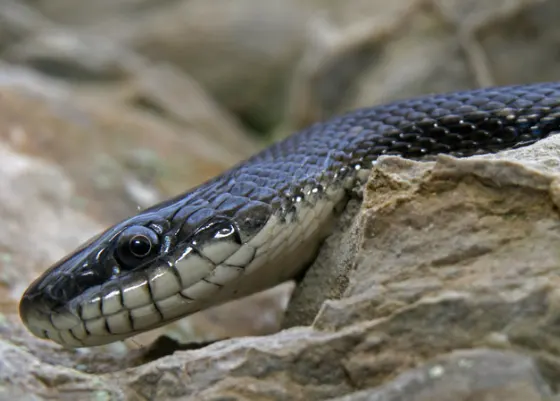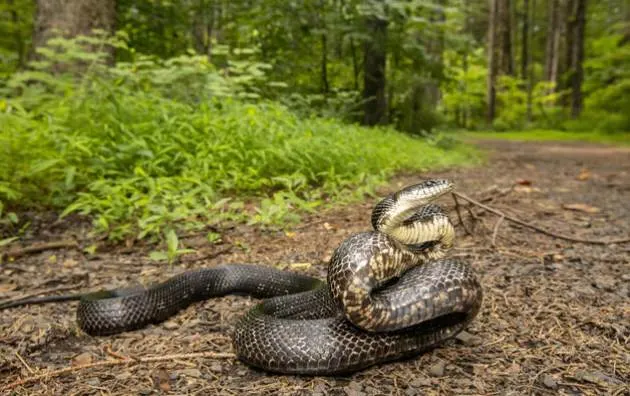The Black Rat Snake, also known as Pantherophis obsoletus, is a captivating species native to the central and eastern United States. Known for their glossy black scales and impressive length, these snakes play a vital role in their ecosystems by controlling the populations of small rodents. This comprehensive guide will delve into the characteristics, behavior, habitat, and more intriguing aspects of the Black Rat Snake.
Table of Contents
Physical Characteristics
Black Rat Snakes are renowned for their striking appearance. Adults typically showcase shiny black scales on their dorsal side and a checkered pattern of gray or tan on their ventral side. They also have a distinctive white chin and neck. Juveniles, in contrast, display a pattern of black and gray blotches that gradually turn black as they mature.
These snakes are among the longest in North America, with adults reaching lengths of up to eight feet. They possess thick, powerful bodies, which aid in their primary method of hunting and defense: constriction.

Habitat and Distribution
Black Rat Snakes are highly adaptable and can thrive in various habitats, including farmlands, rocky hillsides, forests, and even suburban areas. They are primarily found in the central and eastern regions of the United States, with significant populations in states like South Carolina, Ohio, Kentucky, and Missouri.
These snakes prefer temperate climates and undergo a period of brumation during the winter months, typically from October to March. During brumation, they often share dens with other snake species, including venomous ones, though they do not guide or “pilot” these snakes as myths suggest.
Diet and Hunting Behavior
As carnivores, Black Rat Snakes have a diet that includes mice, rats, frogs, birds, and birds’ eggs. They are skilled climbers, often venturing into trees to raid nests. Their method of hunting involves stalking their prey and using their powerful bodies to constrict and suffocate their catch before consumption.
Behavior and Temperament
Black Rat Snakes are generally non-aggressive and shy around humans. When threatened, they have several defense mechanisms. They might freeze and kink their bodies to mimic a stick, release a foul odor, or shake their tails to deter predators. Despite their imposing size, they pose little danger to humans, as they are not venomous.
Reproduction and Lifespan
These snakes are particularly active during the spring and summer months, with breeding occurring in April and May. Females lay clutches of eggs, which hatch into juveniles measuring about one foot in length. Black Rat Snakes can live for over 20 years in the wild, contributing to their role in maintaining ecological balance by controlling rodent populations.
Conservation Status
The Black Rat Snake is classified as “Least Concern” by the IUCN Red List of Threatened Species. Their population is stable, with an estimated adult population of at least 100,000. They are an essential part of their ecosystems, valued for their role in controlling pest populations.
Misconceptions and Myths
A common myth about Black Rat Snakes is that they “pilot” venomous snakes to dens for winter brumation. While they do sometimes share dens with other snake species, there is no evidence to support the idea that they guide these snakes. This myth likely arose from the occasional observation of different snake species cohabitating during colder months.
Black Rat Snake vs. Black Racer
Black Rat Snakes are often confused with Black Racers due to their similar appearance. However, there are notable differences between the two species:
- Body Size and Shape: Black Rat Snakes have thicker bodies compared to the slender, whip-like bodies of Black Racers.
- Scales: The scales of Black Rat Snakes are shiny, while those of Black Racers have a matte finish.
- Behavior: Black Racers are more aggressive and nervous, whereas Black Rat Snakes are docile.
- Hunting Method: Black Rat Snakes constrict their prey, while Black Racers bite and swallow their prey whole.
Interaction with Humans
Black Rat Snakes occasionally find refuge in barns and other structures on farms, seeking shelter from extreme weather or hunting for rodents. They are beneficial to farmers and homeowners by helping to control pest populations. While they can bite if cornered, their bites are non-venomous and usually not serious.
If bitten, it is essential to clean the wound with soap and water, apply first-aid cream, and monitor for signs of infection. Despite their shy nature, these snakes are an important part of the ecosystem and should be respected and protected.
Conservation Efforts and Educational Importance
Conservation efforts for Black Rat Snakes focus on preserving their natural habitats and promoting coexistence with humans. Educational programs in zoos and nature centers help raise awareness about the importance of these snakes in maintaining ecological balance.
Frequently Asked Questions
Are Black Rat Snakes venomous?
No, Black Rat Snakes are not venomous. They kill their prey by constriction, much like boas and pythons.
How do Black Rat Snakes hunt?
Black Rat Snakes hunt by climbing into trees to steal birds’ eggs or baby birds from nests. They also stalk rodents and amphibians through tall grass, constricting their prey until it suffocates.
Are Black Rat Snakes aggressive?
No, Black Rat Snakes are generally non-aggressive. They prefer to avoid confrontation and will use various defense mechanisms, such as freezing, releasing odors, or shaking their tails, when threatened.
What do Black Rat Snakes eat?
Their diet consists mainly of rodents, birds’ eggs, frogs, and other small animals. They are effective at controlling pest populations.
Can Black Rat Snakes bite humans?
Yes, they can bite if they feel threatened or cornered. However, their bites are not venomous and are usually not serious.
Where are Black Rat Snakes found?
Black Rat Snakes are found in the central and eastern United States, in states such as South Carolina, Ohio, Kentucky, and Missouri.
How long do Black Rat Snakes live?
In the wild, Black Rat Snakes can live for over 20 years.

How can you differentiate between a Black Rat Snake and a Black Racer?
Black Rat Snakes have thicker bodies and shiny scales, while Black Racers have slender bodies and matte scales. Additionally, Black Racers are more aggressive and have a different hunting method, biting and swallowing their prey whole instead of constricting.
What should you do if bitten by a Black Rat Snake?
Clean the wound with soap and water, apply first-aid cream, and monitor for signs of infection. If symptoms appear, seek medical attention.
The Black Rat Snake is a remarkable species that plays a crucial role in controlling rodent populations in the central and eastern United States. With their distinctive appearance, impressive size, and fascinating behaviors, they are a subject of interest for both herpetologists and nature enthusiasts. By understanding and appreciating these snakes, we can ensure their continued presence in our ecosystems and promote a balanced natural world.
- Enchi Ball Python: A Unique and Stunning Morph of Python regius - March 27, 2025
- Emerald Tree Monitor: The Enigmatic Green Guardian of the Rainforest - March 26, 2025
- The Egyptian Cobra (Naja haje): A Fascinating Serpent - March 25, 2025
